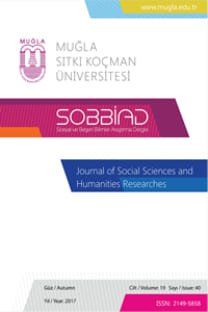DOĞRUSAL OLMAYAN OTOREGRESİF ZAMAN SERİLERİ MODELLERİNİN KESTİRİMİ
Zaman serisi, AR modeli, SETAR modeli, ARM modeli
NONLINEAR TIME SERIES MODELS PREDICTING AUTOREGRESSIVE
Time series, AR model, SETAR model, ARM model,
___
- Altman, N. S. (1990). Kernel Smoothing of Data with Correlated Errors. Journal of the American Statistical Association, 85: 749-759.
- Box, G. E. P., Jenkins, G. M. ve Reinsel, G. C. (1994). Time Series Analysis. New Jersey: Prentice Hall.
- Chan, K. S. ve Tong, H. (2001). Chaos: A Statistical Perspective. Springer Verlag.
- Dagum, E. B. ve Giannerini, S. (2006). A Critical İnvestigation On Detrending Procedures For Non Linear Processes. Journal of Macroeconomics, Elsevier, Vol. 28(1), 175-191.
- Engle, R., Granger, W., Rice, J. ve Weiss, A. (1986). Semi Parametric Esitmates of The Relation Between Weather and Electricity Sales. J. Am. Statist. Ass., 81, 310-320.
- Eilers, P. H. C. ve Marx, B. D. (1996). Flexible Smoothing with B-Splines And Penalties (with discussion). Statist. Sci., 89, 89–121.
- Fan, J. ve Gijbels, I. (1996). Local Polynomial Modelling and its Applications. Chapman and Hall: London.
- Franses, P. H. ve Dijk, V. D. (2000). Nonlinear Time Series Models in Empirical Finance. Cambridge University Press, Cambridge.
- Granger, C. W. J. ve Terasvirta, T. (1993). Modelling Nonlinear Economic Relationships. Oxford University Press, Oxford.
- Green, P. J. ve Silverman, B. W. (1994) . Nonparametric Regression and Generalized Linear Models: A Roughness Penalty Approach. Chapman and Hall, London.
- Hart, J. D. (1991). Kernel Regression Estimation with Time Series Errors. Journal of the Royal Statistical Society, B 53: 173-187.
- Hart, J. D. (1994). Automated Kernel Smoothing of Dependent Data By Using Time Series Cross-Validation. Journal of the Royal Statistical Society, B 56: 529-542.
- Harvey, A. C. ve S. J. Koopman (1993) . Short Term Forecasting of Periodic Time Series Using Time-Varying Splines. J. Amer. Statist. Assoc., to appear.
- Hastie, T. J. ve Tibshirani, R. J. (1990). Generalized Additive Models. New York: Chapman and Hall.
- Henry, Ó., Olekalns, N. ve Summers, P. (2001). Exchange Rate İnstability, A Threshold Autoregressive Approach. Economic Record, 237, 160-166.
- Hurvich, C. M. ve Zeger, S. L. (1990). A Frequency Domain Selection Criterion for Regression with Autocorrelated Errors. Journal of the American Statistical Association, 85: 705-714.
- Pfann, G. A., Schotman, P. C. ve Tschernig, R. (1996). Nonlinear Interest Rate Dynamics and Implications for The Term Structure. Journal of Econometrics, 74, 149–176.
- Smith, M., Wong, C. M. ve Kohn, R. (1998) “Additive Nonparametric Regression with Autocorrelated Errors” Journal of the Royal Statistical Society: Series B: Statistical Methodology, Vol. 60, 2, 311-331.
- Tong, H. (1978). On a Thresold Model. In Pattern Reconition and Signal Processing. (Edited by C. H. Chen), Sijthoff and Noordhoff, Amsterdam, 101-41.
- Tong, H. ve Lim, K. S. (1980). Threshold Autoregression, Limit Cycles and Cyclical Data (with discussion). Journal of the Royal Statistical Society, Ser. B, 42, 245-292.
- Tong, H. (1983). Threshold Models in Nonlinear Time Series Analysis. Lecture Notes in Statistics, Springer-Verlag.
- Tong, H. (1990). Nonlinear Time Series: A Dynamical System Approach. Oxford University Press, Oxford.
- Tong, H. (2007). Birth of The Threshold Time Series Model. Statist. Sinica, 17, 8–14.
- TUİK (2012). Türkiye İstatistik Kurumu. Erişim Tarihi: 04.12.2012, http://www.tuik.gov.tr/VeriBilgi.do?alt_id=13
- Wood, S. N. (2000). Modelling and Smoothing Parameter Estimation with Multiple Quadratic Penalties. J.R. Statist. Soc. B 62, 413-428.
- Zivot, E. (2005). Nonlinear Time Series Models. Erişim Tarihi: 04.12.2012, http://faculty.washington.edu/ezivot/econ584/notes/nonlinear.pdf
- ISSN: 2149-5858
- Yayın Aralığı: Yılda 2 Sayı
- Başlangıç: 2000
- Yayıncı: Mugla Sitki Kocman University
DOĞRUSAL OLMAYAN OTOREGRESİF ZAMAN SERİLERİ MODELLERİNİN KESTİRİMİ
DEVLET VE VAKIF ÜNİVERSİTELERİNDE HİZMET KALİTESİ VE İMAJIN ÖĞRENCİ MEMNUNİYETİNE ETKİSİ
XVIII. YÜZYILDA MUĞLA’DA DİNÎ VE SOSYAL YAPILAR
İzzet GÖRGEN, Halil ÇOKÇALIŞKAN, Ünsal KORKUT
ETİK LİDERLİK VE ÖRGÜTSEL ADALETİN ÖRGÜTSEL SAPMA DAVRANIŞLARI ÜZERİNDEKİ ETKİSİ
